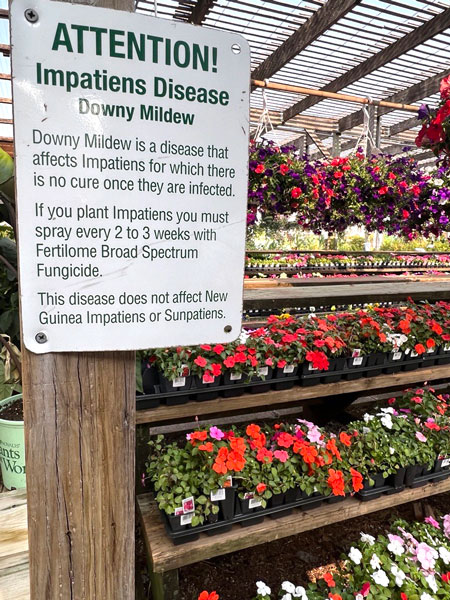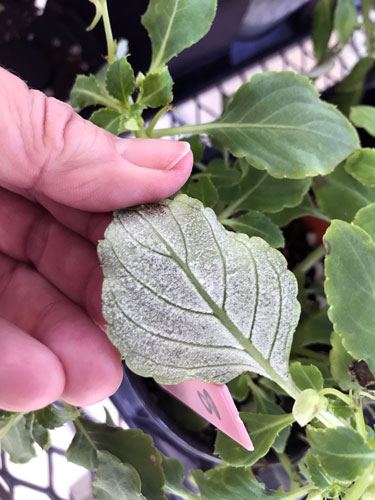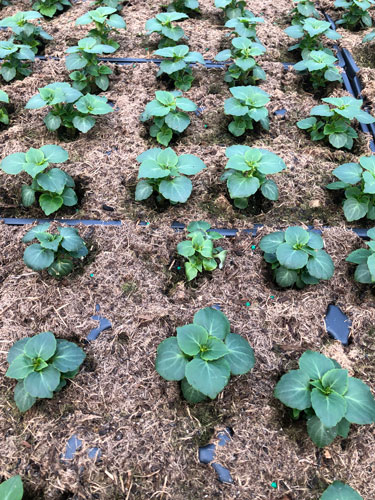2/1/2024
What’s Up With IDM?
Jennifer Zurko

Remember when there was a time when all we talked about was impatiens downy mildew (IDM)? Well, it’s still hanging around. And for some growers and retailers—especially in the Northeast and Southeast—it’s been a continuous problem.
So we thought it would be a good idea to reach out to some of our contacts to check in and see where things stand with regard to impatiens downy mildew and the impatiens market, in general.
“The disease hasn’t gone away and people need to know that,” said Dr. Margery Daughtrey, a long-time plant pathologist at Cornell University’s Long Island Horticultural Research & Extension Center, and one of the industry’s experts on IDM. “You don’t want them to get too depressed because they do have the option of buying relatively resistant plants, but they’re not totally resistant. That’s the basic message.”
Photo: Jen Polanz.
I spoke with Margery and the technical services team at Syngenta to get answers to a few questions.
GrowerTalks: Looking back at IDM when it started, where are we now with the disease?
Margery Daughtrey: There was an outbreak last spring, which is why I can say very emphatically we, meaning the industry, still have it. And that’s associated with, ultimately, production in southern regions where there is no winter, so there’s nothing to stop the cycling of the organism.
If you’re producing in a northern state, it's not going to blow into your vents, most likely, during the production season. But if you’re producing in an area that doesn’t have frost, the possibility is there that it will blow in from some landscape planting in your town. And then that makes you more vulnerable and your customers end up being vulnerable.
Syngenta Tech Services: The disease is still present and has been seen in both the resistant and non-resistant impatiens series. With more of the resistant genetics being grown and sold in the market, devastating losses in the landscape have been less.
 GT: Now that it’s been 10 years since we’ve been dealing with this, how do you think the market has been affected?
GT: Now that it’s been 10 years since we’ve been dealing with this, how do you think the market has been affected?
MD: There has been less change than I would have expected because there are still plenty of people growing susceptible types, which you find out about when there’s an outbreak. Very few people have limited themselves to just Imara and Beacon. It seems like there is a market for “cheaper” impatiens, so that’s what’s driving that. I was surprised—I really thought everyone would go to the safer ones once they had the option. They don’t seem to have done that. And they do still seem to want impatiens; I still see a real interest in the crop. We have had a lot more people growing begonias and vincas and New Guinea impatiens than ever did before, though. It’s broadened people’s choices. But there are still a lot of impatiens in this area. They’re very popular.
Photo courtesy of Syngenta Tech Services.
STS: The improved habits, flowering, heat tolerance and garden performance of the interspecific New Guinea impatiens have led to some growers producing more of this class than Impatiens walleriana. That is a given, and with a higher price point to justify migrating that way is an industry reality. Having said that, we still see purchases of IDM susceptible series. Impatiens walleriana is an important shade species with vibrant color and great garden habit. We do see more hanging basket production of the IDM-susceptible series and less pack production. Having the susceptible series plants in baskets and premium pots with a formidable fungicide program translates to success.
GT: What about new research? Are there any new protocols to prevent or treat the disease?
MD: I think in the garden it’s hopeless because no one can do the repeated protective actions that would be necessary, so a highly resistant plant is what is needed for the garden.
When it comes to production—boy, you know they have the perfect environment in there for it and they have zero tolerance for it, really. [Growers] can prevent the disease by using chemistry that’s effective, but once downy mildew starts expressing itself, by the time they detect it, it has spread throughout—even if you put the best chemicals we’ve got on you can’t ream it out from the plants. So it’s not something you can afford to get in your greenhouse. It’s something you can only afford to prevent if you’re in one of the areas that has more risk or have customers that are going to get upset if you send it to them. You should be preventing against it during the production phases in order to avoid an uncontrollable disease. The basil people know the same thing—it’s just not something that you can stop. It’s a very fast epidemic and really harmful, and immense trouble for your customers.
 STS: Syngenta Professional Solutions has several products—including Subdue Maxx, Micora and Segovis fungicides—that are very effective on this pathogen and should be used for preventing this disease. Subdue Maxx and Segovis are systemic and should be applied in the beginning and toward the end of production. We refer to this as the “systemic sandwich” with protectant products like Micora or Mural used in between. This rotation has been tested numerous times and keeps plants free of infection while in production and has provided over 12 weeks of control in the landscape setting. When this is paired with resistant genetics, it’s a recipe for success.
STS: Syngenta Professional Solutions has several products—including Subdue Maxx, Micora and Segovis fungicides—that are very effective on this pathogen and should be used for preventing this disease. Subdue Maxx and Segovis are systemic and should be applied in the beginning and toward the end of production. We refer to this as the “systemic sandwich” with protectant products like Micora or Mural used in between. This rotation has been tested numerous times and keeps plants free of infection while in production and has provided over 12 weeks of control in the landscape setting. When this is paired with resistant genetics, it’s a recipe for success.
Pictured: Yellowing and dropping of leaves were indications of downy mildew in this highly resistant impatiens crop grown in New York in 2023. Photo: Nora Catlin.
GT: Do you think that the resistant varieties (Beacon from PanAmerican Seed and Imara from Syngenta) will eventually completely replace the “old” Impatiens walleriana?
MD: In this area [in the Northeast], because people have really been burned by having susceptible impatiens, most of the growers here grow just the resistant ones. But they will bring in a few doubles, so they are bringing in more risk, which can reduce the safety of what they started with, growing the new genetics. But I think in other regions of the country they may be less inclined to invest in the resistant ones because they’re not as sensitive to it. I think the Northeast is the most touchy with regard to that disease and its affects. So the Northeastern market is the one, I would suspect, where the highest percentage of the resistant lines are sold.
(Editor’s note: According to Ball Seed, they sell the most units of Imara and Beacon in the Great Lakes and Southeast regions of the country, followed by the Northeast.)
GT: Do you think growers that have been burned by IDM are trying the resistant varieties? Or have they totally given up on Impatiens walleriana?
MD: Here in the Northeast, I would say they’re definitely growing Beacon and Imara. I don’t think I’ve ever talked to anyone who’s said, “I’m not growing impatiens anymore.” It’s such a strong crop here, they’d be really hurting themselves by not having it in their mix.
GT: Do growers who’ve been faced with IDM feel like they’ve been able to keep it under control?
STS: The grower community relies on young plant suppliers to implement effective fungicide rotations that prevent and suppress the disease, especially on highly resistant series. No Impatiens walleriana series in our industry is immune to IDM. When those protocols aren’t in place and the disease triangle is present, that’s when disappointment transpires. The majority of growers have adopted and demonstrated a strong rotation program in susceptible and highly resistant series. There are cases of where growers haven’t been as proactive with an assumption the disease isn’t as prevalent in the environment, whether due to low inoculum or drier growing season conditions. They’re growing a “resistant variety” and feel there’s no need for protection, and that’s when issues pop up. Cool, wet springs and early summers increase the odds of pathogen activity.
GT: So is IDM still a main disease we still have to worry about?
MD: I think it’s Number 1 because of that high transmissibility factor. Thank goodness for the Beacons and Imaras because that’s reduced how many people are really burnt by it. But they still haven’t made the disease a non-entity—it’s still significant. If we had everyone start growing older types of impatiens again, then we’d suddenly realize how much of it was still in the system.
Other crops have their plagues, too. But if I were a bedding plant grower and I had significant sales in impatiens, I’d think of this as the main thing to worry about and I’d make decisions based on it. We’d like to think everybody is used to managing Botrytis, but in that case there aren’t really alternative plant choices. In the impatiens’ case, there is a choice of highly resistant plants and I wish more people would take advantage of it. I think more people will over time—it’s an evolution.
GT: There was a time that people worried that we would “lose” impatiens—is it too much to say that the resistant varieties helped save the crop?
STS: We don’t see the market losing Impatiens walleriana. Staying ahead of the disease, continuing to breed resistance—recognizing that these diseases mutate and evolve keeps the breeding pipeline active. Newer chemistries with different Modes of Action are constantly being screened and tested, and will only support the future existence of Impatiens walleriana. While there are other great species for the shade, nothing beats Impatiens walleriana.
MD: The point I’d like to make is to continue research—in house or otherwise—and to continue improving the genetics. Not just because we want to get the broader [color] palette, but also because the organism is going to be continually changing, too. The resistance isn’t perfect to start with and you can always have a mutation that might make the downy mildew better able to attack a new line. So we need constant monitoring, constant development—we’re going to have to try and stay ahead of this disease forever now. GT
Say Bye-Bye to Super Elfin
I also spoke with Lisa Lacy, Director of Product Management for PanAmerican Seed, because I’d heard that PanAmerican is planning on completely dropping its longtime Impatiens walleriana series Super Elfin, which will be replaced by the IDM-resistant Beacon series.
“That’s absolutely correct, yes,” she said. “Actually, PanAmerican Seed stopped offering Super Elfins, and all of our other susceptible varieties, in May 2023. We’ve discontinued the production and we’re selling through the inventory.”
Once they go through all of the inventory that’s left, that’ll be it because Lisa said they will completely focused on Beacon. As Margery mentioned above, there are still growers that are producing the more susceptible varieties, so I asked Lisa if they were getting any push-back from the traditionalists.
“There have been some inquiries about why we’re dropping them, but we’re doing it for multiple reasons,” she explained. “We believe it’s just the best solution for the global marketplace, something that has high resistance, the need for less chemical use. I think one of the challenges is we don’t yet have the complete color range, so some growers may be using some Super Elfins to back-fill on some colors that aren’t in Beacon.”
Lisa said that PanAmerican’s breeding team is continuing to not just develop new colors, but to also work on upgrading and improving the current colors, even though the series isn’t that old.
“We’ll continue to fill in on key colors,” she said. “The additions of Rose and Lipstick were very important.”
And since there are some regions that haven’t been hit as hard with IDM, the growers in those areas may feel like they can safely grow the older series, but “it’s a sneaky disease, as we know,” said Lisa. “We need to have a product that best protects the grower and the consumer market, so that’s why we’ve completely focused on Beacon. It’s offered a solution to help bring back one of the top bedding plants in the market.” —JZ